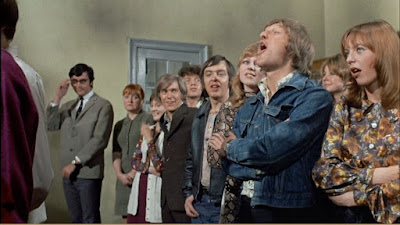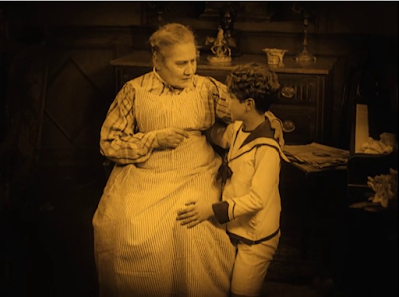One of the biggest box office hits in Britain of 1972, when,
Lord knows, we could do with a laugh, Please Sir! is one of those very
rare beasts, a film based on a TV series that works on its own terms but also
as an extension of the spirit and sensibilities of the series. Removed from the
context of its source medium and, further, the school setting that created the
situation, Please Sir! finds a new comedic environment with which to
extend its mix of class and generational conflict in the more cinematic
location of the great outdoors, albeit it just down the road from Pinewood
Studios.
As David Barry (Frankie Abbott in 5c) says in one of the
extras, the TV series was hugely popular and was even pulling in more viewers
than Coronation Street at one point. As with Dad’s Army you had the eternal
comedic conflict between the establishment of school authorities and beyond and
the working-class kids (mostly in their 20s) who are written off as a bad job
by almost all around them. There's some genuine pathos here amongst the (barely) scholarly slapstick.
The one person willing to take their side and who still
has hopes for them is their teacher Bernard “Privet” Hedges as played by charming
and quick-witted John Alderton who, in addition to having a certain
McCartney-esque look, is able to convey a mixture of naivety and principled resolve.
Bernard’s one of the most well-constructed comedy characters of the era because
of these contradictions, his hesitancy almost always followed through by response and perhaps the sound of his hand gently slapping the back of a boy’s
head. It’s hard to imagine any other performer holding these
opposing forces together with a much likeability, ease and charm as Alderton and
it was, as much as Arthur Lowe’s Captain Mainwaring, one of the iconic roles of early seventies sit-com.
 |
| John Alderton, Patsy Rowlands and Liz Gebhardt |
There’s also, as with Dad’s Army, a superb troup of other
performers who all score goals. There’s the magnificent Deryck Guyler – Wallasey’s
finest - as Norman Potter, an ex-soldier with feet of clay who hates the pupils
just as much as he loves his “senior officers” and relishes every small expression
of authority even though the gang invariably run rings around him. The object
of Potter’s loyalty, Headmaster Maurice “Oliver” Cromwell (Noel Howlett), is liberal and literal-minded, possibly a future-state Bernard who has ascended to a
state of euphoric denial.
Whilst Potter puffs him up, the fearsome Doris Ewell (the wonderful
Joan Sanderson) grounds him with her cynicism and political nouse. Mr. Price
(Richard Davies) is of the Welsh persuasion and whilst just as cynical as Miss
Ewall, lacks the gumption to do anything other than hang on in there and grab a
beer when he can. Then there’s lovely old Erik Chitty as Mr Smith, a Godfrey
figure – he was in Dad’s Army a number of times himself - who is occasionally called
upon to deliver clarity to the situation.
Last but not least amongst the staff is Patsy Rowlands as
the lovelorn Angela Cutforth, who holds at least four candles for Mr Hedges, a
specialist in these types of roles – remember her affection for Kenneth
Williams in Carry on at Your Convenience – she is the perfect emblem of The
School Crush.
 |
| Carol Hawkins, Sir and Peter Cleall |
This is where the series and the film scores as, in the
world after Just William and before Tucker Jenkins (young Todd Carty is uncredited
with a bit part in assembly fact fans), this series was one of the first to
plug into our shared experience and it was far more Bash Street Kids than Billy
Bunter at Greyfriars. The Fenn Street gang were rough and real albeit to
varying degrees… Peter Cleall’s Eric Duffy was the class alpha, always ready
with a quip and a comeback, cocky with a heart of gold. He is going out with the
equally assured Sharon Eversleigh, played in the series by Penny Spencer and
here by the radiant Carol Hawkins who then continued the role in the follow up
series, The Fenn Street Gang (1971-3). Karen Gough in my class had the same feather cut as Carol... and I was dead impressed.
Sharon’s pal Maureen Bullock (Liz Gebhardt) is an earnest
young woman of faith who has as big a crush on Mr Hedges as Miss Cutforth. She’s
another relatively nuanced character with a lot of good lines highlighting the
gulf between secular reality and the faith upon which the daily routines of
education are based. The film begins with assembly and All Things Bright and
Beautiful which couldn’t be further from the actuality.
Even more divorced from this reality is Frankie Abbott
who, lives in a world of childish fantasy drawn from comics and films with his
mother (Barbara Mitchell) doting on her “baby”, the two holding each other back.
More grotesque is the family of day-dreamer Dennis Dunstable (Peter Denyer), presumably
with special educational needs in modern parlance, who has a Dickensian bully of
a father (Peter Bayliss) who cares not for his son’s learning or wellbeing.
Authority in harmony: Noel Howlett and Joan Sanderson
Rounding out the main players are Malcolm McFee as Peter
Craven, a smooth-talking jack the lad, Aziz Resham as Feisal, and former Double
Decker, future reggae superstar in Aswad, Brinsley Forde as Wesley. Both the
latter characters are used to address the race issue and in ways that, for the
time, are reasonably subtle. Talking of which, the school bus is driven by Jack Smethurst, star
of Love Thy Neighbour which was as heavy-handed on this issue as it was possible to be.
The plot? 5c, after special pleading from Hedges worthy
of Gregory Peck’s Atticus Finch, are allowed to go on the annual school trip to
a summer camp, with his reputation on the line if they fail to live up to his
expectations and do exactly what Miss Ewell and the rest expect. In the course
of their journey from inner London to the shires, Wesley is lost and picked up
by airline stewardess, Penny Wheeler (Jill Kerman), who he persuades that
Mr Hedges is a racist bully, a joke that persists once she also turns up as the
barmaid in the local pub.
Jill Kerman and Brinsley Forde
Amidst the rom-com and the inevitable chaos of the city
kids in the country alongside posh grammar school students, there’s some
touching loyalties displayed between 5c and Bernard. The series’ ultimate
message being that education is about support, patience and tolerance... and you
know that can’t be bad.
The digital transfer is excellent, revealing even a little
of John Alderton’s foundation, but making everything as fresh as the comedy.
There’s also a host of special features:
• New interviews with actor David Barry (Frankie Abbott),
composer Mike Vickers, second assistant director Nicholas Granby, unit
publicist Tony Tweedale and assistant editor Christopher Ackland
• 1970 TV Awards sketch
• John Alderton interview with Gloria Hunniford from 1987
• Theatrical trailer
• Image gallery
• There’s also a limited-edition booklet written by Jade
Evans which is a thoroughly researched and eloquent as you would expect given
her love for the subject.
Please Sir! Is available from 29th
August on both DVD and Blu-ray and you can order it direct from those nice folks at Network.
_1.png) |
| Note the graffiti... I think we can all agree that Liverpool Football Club are indeed great! |




%20breakdown.png)
.png)
%20performers.png)

.png)
_-_1.jpg)
%20fiddle.png)
%20dream%201.png)
.png)
%20lake.png)

.png)
.png)
%20dream%20outside%20in.png)


%20violin%202.png)

%20breakdown%202.png)
%20Despair.png)
%20micro%202.png)
%20sad%20songs%20mean%20so%20much%202.png)
%20Demonic.png)
%20cocaine.png)
%20Dope.png)
%20Radio%20Waves.png)

+colour.png)








